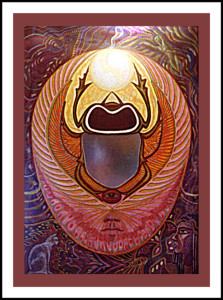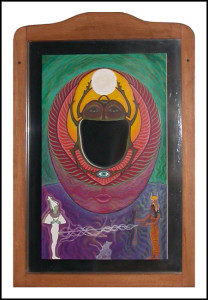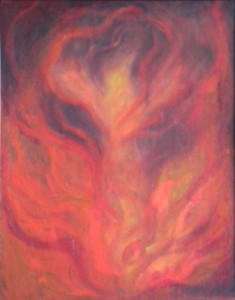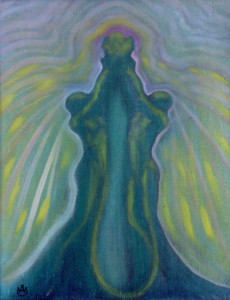“Great art is the outward expression of an inner life in the artist, and this inner life will result in his[her] personal vision of the world. No amount of skillful invention can replace the essential element of imagination. One of the weaknesses of much abstract painting is the attempt to substitute the inventions of the intellect for a pristine imaginative conception. The inner life of a human being is a vast and varied realm and does not concern itself alone with stimulating arrangements of color, form, and design. The term ‘life’ as used in art is something not to be held in contempt, for it implies all of existence, and the province of art is to react to it and not to shun it. Painting will have to deal more fully and less obliquely with life and nature’s phenomena before it can again become great.”
– Edward Hopper (22 July 1882 – 15 May 1967)
 1978 started off with an unusual project stimulated by finding a discarded, slightly damaged, framed mirror approximately 24″ x 16″ on the street. Who knows where the idea came from of drawing a space helmet à la Egyptienne on paper with an area cut out in the middle the size of a face? Chariots of the Gods by Erich von Daniken? Possibly. The finished drawing – done with luma dyes plus colored pencil highlights – was superimposed over the found mirror, with a piece of non-glare glass to protect the whole. The combination of non-glare glass over mirror caused the reflection in the face area to be very diffused with no sharp edges, like “seeing through a glass darkly.” I lived with the piece in NYC for the remainder of my time there, taking it along with me to Portsmouth NH. When I moved to Philly in ’86, the mirror went into storage in my dad’s barn in Dayton, Maine. At some point in the ’90s it went missing, and no one in the family seemed to have any idea what had happened to it, when I asked after its possible whereabouts. Borrowed? Stolen? Who knows, another piece of AldenArt appreciated elsewhere hopefully. Am I flattered? Absolutely; it’s better than thinking the piece got trashed and wound up in a landfill.
1978 started off with an unusual project stimulated by finding a discarded, slightly damaged, framed mirror approximately 24″ x 16″ on the street. Who knows where the idea came from of drawing a space helmet à la Egyptienne on paper with an area cut out in the middle the size of a face? Chariots of the Gods by Erich von Daniken? Possibly. The finished drawing – done with luma dyes plus colored pencil highlights – was superimposed over the found mirror, with a piece of non-glare glass to protect the whole. The combination of non-glare glass over mirror caused the reflection in the face area to be very diffused with no sharp edges, like “seeing through a glass darkly.” I lived with the piece in NYC for the remainder of my time there, taking it along with me to Portsmouth NH. When I moved to Philly in ’86, the mirror went into storage in my dad’s barn in Dayton, Maine. At some point in the ’90s it went missing, and no one in the family seemed to have any idea what had happened to it, when I asked after its possible whereabouts. Borrowed? Stolen? Who knows, another piece of AldenArt appreciated elsewhere hopefully. Am I flattered? Absolutely; it’s better than thinking the piece got trashed and wound up in a landfill.
 Isis and Osiris Mirror • drawing: oils and colored pencil on watercolor paper • 30″ x 20.5″ • collection of the artist.
Isis and Osiris Mirror • drawing: oils and colored pencil on watercolor paper • 30″ x 20.5″ • collection of the artist.
In 2000, twenty years after making the first version, I revisited the concept, again stimulated by finding another slightly damaged, framed mirror on another street, this time in Philadelphia. I created a new piece of art, based loosely on memories of the missing piece, but with significant compositional changes. Again I used the same combination of non-glare glass over art and mirror, which creates a ghostly, other-worldly reflection. This one has not been stolen or borrowed (yet), and continues to be on view here at the emporium.
 Fire Flower • oil on canvas-board 20″ x 16″ • collection of the artist
Fire Flower • oil on canvas-board 20″ x 16″ • collection of the artist
As the year progressed I turned my attention to a pair of 16″ x 20″ canvas boards that had been in my possession for quite some time, which seemed like the perfect surfaces for a little experimentation. The inspiration for the first was heat; the final immolation scene from Wagner’s Gotterdammerung. Originally intended to be more illustrative of Brunhilde’s invoking of Loki, the fire god, to intervene in the drama, cleansing the world of corruption, the last reworking of the canvas sometime in the early 80s took the easier route of going abstract, stimulated by staring into open fires watching the lick of flames consume anything flammable, which I’d done recently.
 Trinity Green • oil on canvas-board 20″ x 16″ • collection of the artist
Trinity Green • oil on canvas-board 20″ x 16″ • collection of the artist
The inspiration for this companion piece was coolness; a waterfall of color in cooler tones created right around the same time as FireFlower in the early winter of ’78, filled with thoughts of spring, new growth and green leaves to compensate for another winter of discontents with myself. Musical inspiration? possibly Hector Berlioz’ L’Enfance du Christ (The Infancy of Christ) where Mary and Joseph rhapsodize about their new born child Jesus. Exquisitely beautiful music written around 1854, that I find profoundly moving, knowing I’ll not have that experience of parenting a child in this lifetime.




{ 0 comments… add one now }